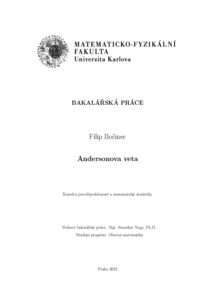Andersonova veta
Anderson's theorem
Andersonova věta
bachelor thesis (DEFENDED)

View/
Permanent link
http://hdl.handle.net/20.500.11956/175662Identifiers
Study Information System: 235985
Collections
- Kvalifikační práce [11819]
Author
Advisor
Referee
Lachout, Petr
Faculty / Institute
Faculty of Mathematics and Physics
Discipline
General Mathematics
Department
Department of Probability and Mathematical Statistics
Date of defense
7. 9. 2022
Publisher
Univerzita Karlova, Matematicko-fyzikální fakultaLanguage
Slovak
Grade
Excellent
Keywords (Czech)
unimodalita|integrál|Brunn-Minkowského nerovnovst|konvexita|vícerozměrná míraKeywords (English)
unimodality|integral|Brunn-Minkowski inequality|convexity|multivariate measureV tejto práci sa budeme zaoberať tvrdením z oblasti reálnej analýzy a geometrie s názvom Andersonova veta. Jedná sa o integrálnu nerovnosť pre symetrické kvázikonkávne funkcie, kde sa integruje cez symetrické konvexné množiny. Andersonovu vetu dôkladne dokážeme. Budeme skúmať, kedy v Andersonovej vete nastane rovnosť a kedy naopak ostrá nerovnosť. Pri štúdiu tejto otázky narazíme na isté problémy v publikovaných vý- sledkoch, ktoré sa pokúsime vyjasniť. V práci sa tiež budeme zaoberať možnými rozšíreni- ami Andersonovej vety. Konkrétne uvedieme výsledky využívajúce grupovú invarianciu a teóriu s-konkávnych funkcií. Ako naznačíme v závere práce, Andersonova veta je užitočný a často používaný nástroj v mnohorozmernej štatistike. 1
In this thesis we explore a theorem from real analysis and geometry called Anderson's theorem. It concerns an integral inequality for symmetric quasi-concave functions, where the integration is done over a symmetric convex set. A thorough proof of Anderson's theorem is given. In addition, we investigate cases in which equality or strict inequality occurs. While studying this topic, we come across some problems in published papers and we try to clarify them. Furthermore, we explore possible extensions of the theorem. In particular, results involving group invariance and theory of s-concave functions are mentioned. As outlined in the final part of the thesis, Anderson's theorem is a useful and widely used tool in multivariate statistics. 1
